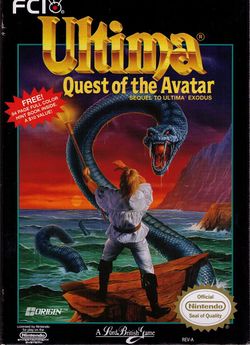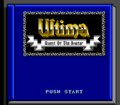
| Ultima IV: Quest of the Avatar | |
|---|---|
| Developer(s) | Infinity |
| Publisher(s) | Pony Canyon, FCI |
| Year released | 1989 |
| System(s) | NES |
| Preceded by | Ultima III: Exodus |
| Followed by | Ultima V: Warriors of Destiny |
| Series | Ultima |
| Genre(s) | Role-playing game |
|---|---|
| Modes | Single player |
Ultima IV: Quest of the Avatar (NES) was developed in Japan in 1989 and localized in English in 1990. It is a remake of Ultima IV: Quest of the Avatar, whereas other console ports of Ultima games are mostly faithful ports (U3-NES, U4-SMS, U6-SNES) or downgraded ports (U5-NES, U7-SNES).
It is the first in the "Age of Enlightenment" trilogy, shifting the series from the hack and slash, dungeon crawl gameplay of its "Age of Darkness" predecessors towards an ethically-nuanced, story-driven approach. Ultima IV is different among role-playing games in that the game's story does not center on asking a player to overcome a tangible ultimate evil.
-
Original Japanese cover
-
Title screen
Story[edit]
After the defeat of each of the members of the triad of evil in the previous three Ultima games, the world of Sosaria underwent some radical changes in geography: three quarters of the world disappeared, continents rose and sunk, new cities were built to replace the ones that were lost. Eventually the world, now unified in Lord British's rule, was renamed Britannia. Lord British felt the people lacked purpose after their great struggles against the triad were over, and he was concerned with their spiritual well-being in this unfamiliar new age of relative peace, so he proclaimed the Quest of the Avatar: he needed someone to step forth and become the shining example for others to follow.

